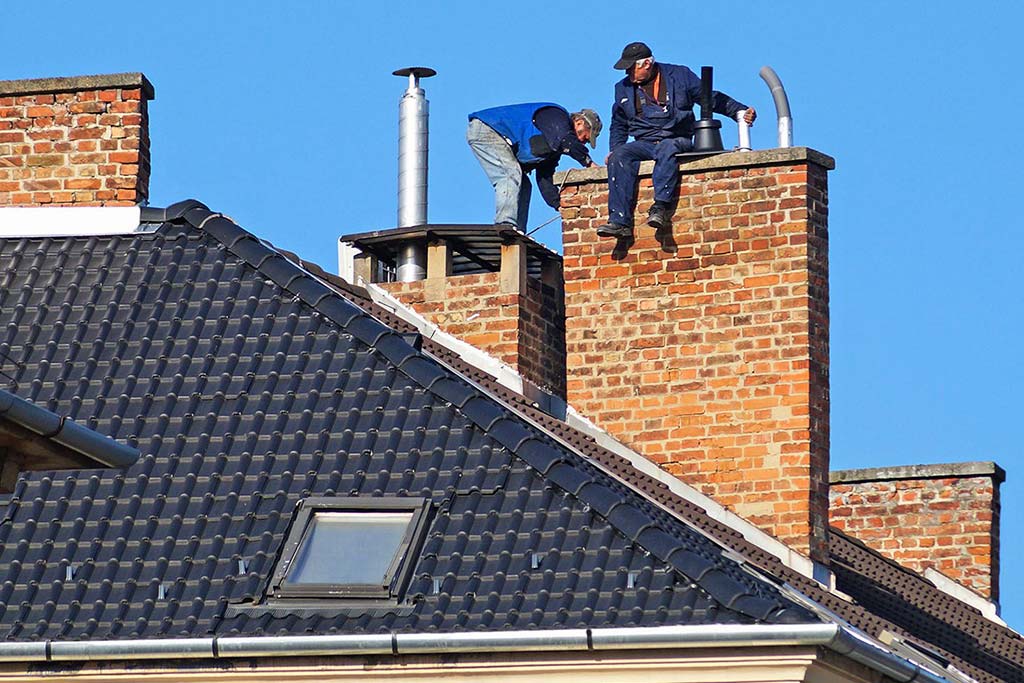Chimney Sweep: Quality Services for a Healthier Living Setting
Chimney Sweep: Quality Services for a Healthier Living Setting
Blog Article
Secure Your Home With Normal Chimney Cleanings by Trusted Professionals
Routine smokeshaft cleanings performed by trusted experts play a crucial role in upholding this requirement. By understanding the signs that suggest when a smokeshaft needs cleansing and the advantages of entrusting this job to skilled professionals, you can guard your home versus unpredicted risks.
Relevance of Chimney Cleanings
Routine smokeshaft cleansings are important for preserving a safe and efficient home heating system. In time, creosote, a result of shedding wood, accumulates inside the chimney. This very combustible compound can stir up and cause a smokeshaft fire if not appropriately gotten rid of. Furthermore, particles such as fallen leaves, branches, or also animal nests can obstruct the chimney, leading to bad ventilation and prospective carbon monoxide buildup within the home.
A clean chimney guarantees that smoke and hazardous gases are safely routed outside, stopping them from seeping into the living space. Routine cleanings can aid determine any structural damage or issues with the chimney that may jeopardize its integrity. Dealing with these problems promptly can protect against expensive repairs or also the demand for a full smokeshaft substitute in the future
Threats of Overlooking Chimney Maintenance
Overlooking proper chimney upkeep poses considerable threats to both the safety and effectiveness of a home heating system. Furthermore, obstructions triggered by debris or animal nests can obstruct the circulation of smoke and gases out of the smokeshaft, boosting the danger of carbon monoxide poisoning within the home.
Additionally, neglecting smokeshaft maintenance can result in structural concerns. Inefficient air flow due to an unclean or obstructed chimney can additionally trigger poor burning, decreasing the home heating system's effectiveness and potentially raising energy costs.
Routine chimney examinations and cleanings by relied on professionals are crucial to prevent these dangers and make sure the safe and reliable procedure of your home heater.

Indicators Your Chimney Needs Cleansing
When considering the maintenance of your chimney, it is essential to be aware of the signs indicating the need for cleansing. One famous indicator that your smokeshaft needs cleaning is when you discover a strong, unpleasant smell coming from your fire place.
In addition, if you observe a substantial quantity of smoke entering your home when making use of the fireplace, it might be an indication that the chimney is blocked and in need of cleansing. If you hear uncommon noises like chirping or waving coming from the smokeshaft, it may show the existence of animals or birds nesting inside, signifying the demand for an extensive cleaning to get rid of any type of blockages and possible dangers. chimney sweep. Regular examinations and cleanings by relied on professionals can help prevent these concerns and make sure the safety and performance of your chimney
Advantages of Expert Chimney Cleanings
Offered the potential dangers linked with an overlooked smokeshaft, seeking professional chimney cleanings can give homeowners with a positive option to keeping a safe and effective fire place system. Professional chimney cleanings use numerous advantages that add to the overall health of both the home and its occupants.
First of Related Site all, expert smokeshaft cleansings aid protect against chimney fires by removing extremely combustible creosote build-up. Creosote buildup in the smokeshaft postures a significant fire risk, and routine cleansings can minimize this danger. Second of all, clean smokeshafts make sure correct air flow, allowing smoke, gases, and various other byproducts of burning to securely leave the home. This not just maintains indoor air quality yet additionally lowers the chance of carbon monoxide gas poisoning.
Moreover, expert smokeshaft cleansings can prolong the lifespan of the smokeshaft and fireplace system by identifying and addressing prospective problems early on. By discovering and repairing damages quickly, homeowners can stay clear of expensive repair work or replacements in the future. Go Here Generally, investing in specialist chimney cleansings is a positive measure that enhances safety, performance, and longevity of the fire place system.
How Usually to Arrange Cleansings
To preserve a safe and reliable fireplace system, it is necessary for property owners to develop a regular timetable for smokeshaft cleansings. The regularity at which you must schedule chimney cleansings can vary depending upon numerous elements. As a general guideline, the National Fire Defense Association (NFPA) suggests that smokeshafts ought to be checked a minimum of when a year, with cleansings done as required. Nonetheless, if you use your fire place frequently, shed a great deal of wood, or discover any kind of signs of creosote buildup or obstructions, even more constant cleanings may be needed.
Along with the NFPA guidelines, it is also recommended to have your chimney examined and cleaned before the start of the burning season to ensure that it is in great functioning problem. An expert smokeshaft sweep can evaluate the state of your chimney and advise an appropriate cleaning timetable based upon your use and the condition of your chimney. By following a normal chimney cleansing timetable, you can stop prospective risks and keep your home safe and cozy throughout the chillier months.
Final Thought

Report this page